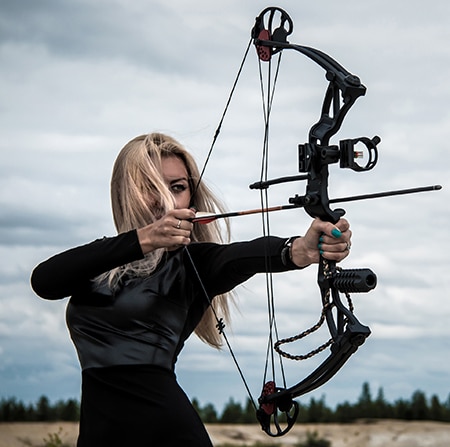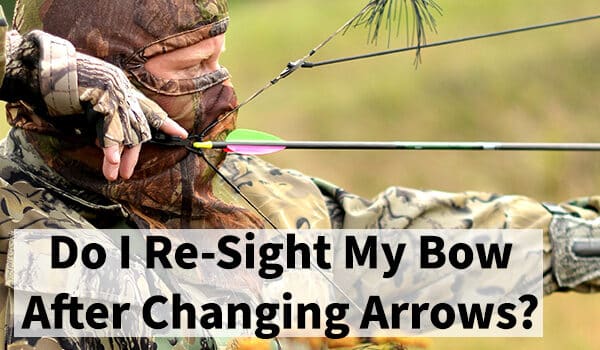Fletching Matters: The Art of Arrow Flight in Bow Hunting
Over the years, I’ve experimented with various fletching configurations, and I can confidently say that it does matter how fletchings are positioned when firing an arrow. In this How to Position Arrow Fletching When Shooting blog post, I’ll share my experiences, insights, and knowledge on this subject, exploring the impact of fletching design on arrow flight and accuracy.
Table of contents
Understanding Fletching

Understanding fletching can help every archer and bow hunter improve accuracy. Fletching, the vanes or feathers attached to the rear end of an arrow, plays a crucial role in stabilizing the arrow during flight and guiding it toward the target. Different fletching materials, configurations, and sizes offer distinct advantages, impacting arrow performance and accuracy.
Feathers are forgiving but weather-sensitive, while vanes are durable and versatile. Fletching configurations like straight, helical, and offset influence stabilization and trajectory, catering to various shooting styles and scenarios. Additionally, fletching color serves practical purposes, enhancing visibility and aiding in arrow recovery. Mastering the art of fletching empowers archers to optimize their arrows for specific purposes, whether it be precision target shooting or successful hunting expeditions.
What is Fletching?
Fletching refers to the small vanes or feathers attached to the rear end of an arrow. They stabilize the arrow during flight and counteract any inconsistencies in arrow release and form.

Importance of Fletching in Archery
Fletching serves three primary purposes:
- Stabilization: Fletchings stabilize the arrow, keeping it straight and consistent.
- Guidance: By creating drag, fletchings correct any minor deviations in the arrow’s flight, guiding it towards the target.
- Orientation: The orientation of fletchings ensures that the arrow’s broadhead or point aligns correctly for optimal penetration.
Impact of Fletching Design on Arrow Flight
The impact of fletching design on arrow flight is significant. It directly influences the arrow’s stability, guidance, and overall accuracy. The choice between feathers and vanes affects flight characteristics. Feathers are more forgiving but weather-sensitive, and vanes are durable and weather-resistant.
Fletching configuration, such as straight, helical, or offset, determines the level of stabilization and guidance the arrow receives.

Additionally, fletching length and size play a role in drag generation, which affects arrow trajectory and speed. By understanding and fine-tuning fletching design, archers can optimize their arrows for specific purposes, whether hunting, target shooting, or both.
Fletching Material: Feathers vs. Vanes
- Feathers:
- Lighter weight, providing a more forgiving flight.
- Greater sensitivity to weather conditions, affected by wind and rain.
- Quieter during arrow flight, making them ideal for hunting.
- Vanes:
- Durable and resilient, offering consistent performance in varying weather.
- Heavier, resulting in a flatter trajectory and potentially better accuracy.
- Louder during flight, less suitable for hunting stealthily.
Fletching Configuration: Straight vs. Helical vs. Offset
- Straight Fletching: Straight fletching refers to the configuration of the vanes or feathers on an arrow. The fletchings are aligned in a straight line along the back or shaft of the arrow. This means that all the vanes or feathers are parallel to each other and form a straight pattern.
- Provides minimal stabilization and guidance.
- Suitable for long-distance target shooting with little wind interference.
- Helical Fletching: Helical fletching refers to the configuration of the vanes or feathers on an arrow. The fletchings are angled in a spiral or helix pattern along the back or shaft of the arrow. This means that each vane or feather is set at a specific angle, causing the fletchings to wrap around the arrow shaft in a circular or helical manner.
- It creates a spiraling effect on the arrow, enhancing stability and correcting flight inconsistencies.
- Ideal for broadhead arrows used in hunting scenarios, ensuring better accuracy and penetration.
- Offset Fletching: An offset fletching is set at a slight angle but not in a full spiral like helical fletchings. Each vane or feather is positioned with a small offset or cant to one side of the arrow shaft, creating a slight angle or twist.
- Less spin than helical but more than straight fletching.
- Balances stability and speed, popular among 3D target archers.
Length and Size
- Fletching Length:
- Longer fletchings provide increased stabilization.
- Shorter fletchings offer more speed and are preferred by target archers.
- Fletching Size:
- Larger fletchings generate more drag, stabilizing the arrow further.
- Smaller fletchings reduce drag, providing a flatter trajectory and increased speed.
Compound Bow Rest Considerations

A “compound bow” uses a system of pulleys and cables to generate more power and efficiency than traditional bows. Regarding the fletching (the feathers or vanes) on arrows used with a compound bow, the orientation does matter to some extent. It primarily depends on the arrow rest used on the bow.
- Drop Away Rest: With a drop-away arrow rest, the fletching orientation does not matter much. Because the rest drops away as the arrow is shot, allowing the fletching to clear the rest without interference.
- Whisker Biscuit Rest: A whisker biscuit rest, it is crucial that the fletching is oriented correctly. A whisker biscuit has vertical bristles that hold the arrow in place, and the fletching needs to pass through them cleanly upon release. You’ll want to position the cock feather (the odd-colored vane, typically) in a way that aligns with the vertical opening of the biscuit. In contrast, the other two fletchings should be positioned outside the bristles.
- Shooting Off the Shelf: Some archers shoot compound bows off the shelf, similar to traditional bows. In this case, the fletching orientation can also matter. Shooters often use a slight helical or offset orientation to stabilize the arrow better during flight.
The Significance of Fletching Color
When shooting an arrow, the position of the fletching relative to the arrow rest is crucial for ensuring consistent arrow flight and accuracy. Proper fletching orientation helps stabilize the arrow during its flight, making it essential to nock the arrow correctly.
Recommended Method for Positioning the Fletching
- Identify the Cock Feather or Index Vane: The fletchings on an arrow typically consist of three vanes or feathers. One of these vanes is usually a different color from the other two and is known as the “cock feather” or “index vane.”
- Align the Cock Feather or Index Vane with the Arrow Rest: To position the fletching correctly, place the cock feather or index vane perpendicular to the arrow rest. This means the odd-colored vane should point directly away from the bow and be at a right angle to the arrow rest.
- Determine Your Bow Hand Orientation: The bow is held in the left hand for right-handed archers. In this case, the cock feather or index vane should be facing away from the bow towards the archer’s left side. For left-handed archers, the orientation is reversed.
- Consistency is Key: Always nock the arrow with the same fletching orientation to ensure consistent arrow flight. This means using the same cock feather or index vane alignment for every shot.
- Helical or Offset Fletching: If your arrows have helical or offset fletching, ensure the cock feather or index vane is correctly aligned with the arrow rest, taking into account the twist of the fletchings.
Following these steps and paying attention to the fletching’s correct orientation can achieve more accurate and repeatable shots. Consistency in nocking the arrow and aligning the fletching with the arrow rest will lead to improved arrow flight and better overall archery performance. Always remember to check your fletching before each shot to ensure it is correctly aligned for optimal results.
How to Position Arrow Fletching When Shooting Conclusion

In conclusion, the position and design of fletching significantly impact an arrow’s flight and overall accuracy in bow hunting. Feathers or vanes, straight, helical, or offset configurations, and fletching size all play crucial roles in stabilizing, guiding, and orienting the arrow for optimum performance.
I’ve come to appreciate the art of fletching and how these seemingly small parts can make a big difference in the success of my shots. By understanding the characteristics of different fletchings and experimenting with various designs, I’ve fine-tuned my arrows to suit specific hunting scenarios.
How to Position Arrow Fletching When Shooting FAQs
Yes, you can experiment with different fletching types to find the one that best suits your shooting style and purpose.
Consider your shooting preferences, the shooting you’ll be doing (hunting or target), and the weather conditions you’ll likely encounter. Seek advice from experienced archers and try different configurations to find what works best for you.
Feathers are more forgiving but susceptible to weather conditions. Vanes are more durable and perform well in various weather conditions. Decide based on your shooting preferences and the environment you’ll be shooting in.
Fletchings should be replaced when they show signs of wear, damage, or consistent contact with the bow’s arrow rest.
Yes, fletching arrows can be done at home with the right tools and materials. There are various fletching jigs available to assist you in achieving consistent results.



